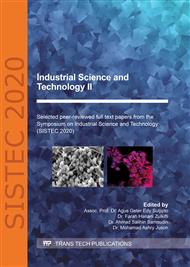p.157
p.163
p.169
p.177
p.185
p.191
p.197
p.204
p.209
Biomineralization of Hydroxyethyl Cellulose/Sodium Alginate for Bone Tissue
Abstract:
The aim of this research is to synthesis biopolymeric materials from hydroxyethyl cellulose (HEC) (5 wt. %) blended with sodium alginate (SA) (10 wt. %) at 1:1 ratio fabricated by using freeze-drying technique. The HES/SA was treated with simulated body fluid (SBF) by immersion technique through the depositing of calcium phosphate on the scaffold’s surfaces. All scaffolds were characterizing by using field emission electron microscope (FESEM), attenuated total reflectance-Fourier infrared transform (ATR-FTIR), and thermogravimetric analysis (TGA). The FESEM images results displayed interconnected porous structure with diameter ranging from 40 to 400 μm with average apatite diameter in range of 95 nm – 148 nm. The ATR-FTIR results exhibit possible interactions between hydroxyl groups of HEC, SA and apatite groups of the scaffolds. The TGA results showed four different regions of mass losses, represents the amorphous transition temperature and water disposal, side-chain bond breaking, pyrolysis of SA and dihydroxylation behaviour of calcium phosphate, respectively. Cell-scaffolds interaction demonstrated that human fetal osteoblast (hFOB) cells differentiated and spread well on scaffolds with better cell proliferation and attachment was more prominent on HEC/SA treated with SBF. Since these biocompatible and biodegradable scaffolds showed promising results, these scaffolds could be adopted for the design of next-generation tissue-engineered bone grafts.
Info:
Periodical:
Pages:
185-190
Citation:
Online since:
March 2021
Price:
Сopyright:
© 2021 Trans Tech Publications Ltd. All Rights Reserved
Share:
Citation:


